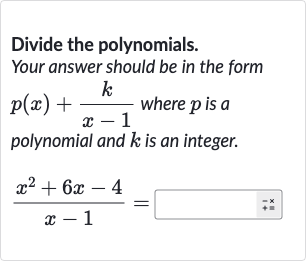Full solution
Q. Divide the polynomials. Your answer should be in the form where is a polynomial and is an integer.
- Set up long division: Set up the long division.We will use long division to divide the polynomial by .
- Divide first term: Divide the first term of the dividend by the first term of the divisor. Divide by to get . This will be the first term of the quotient.
- Multiply divisor and quotient: Multiply the divisor by the first term of the quotient.Multiply by to get .
- Subtract result: Subtract the result from the dividend.Subtract from to get .
- Bring down next term: Bring down the next term. Since there are no more terms to bring down, we proceed to the next step.
- Divide new term: Divide the new term by the first term of the divisor.Divide by to get . This will be the next term of the quotient.
- Multiply divisor and new term: Multiply the divisor by the new term of the quotient.Multiply by to get .
- Subtract result: Subtract the result from the new term of the dividend.Subtract from to get .
- Check degree of remainder: Since the degree of the remainder () is less than the degree of the divisor (), we cannot continue the division.The remainder is , and the quotient is .
- Write final answer: Write the final answer in the form .The quotient is and the remainder is , so the final answer is and .

